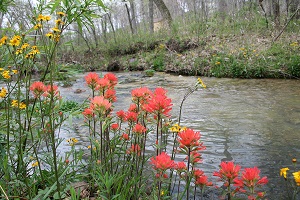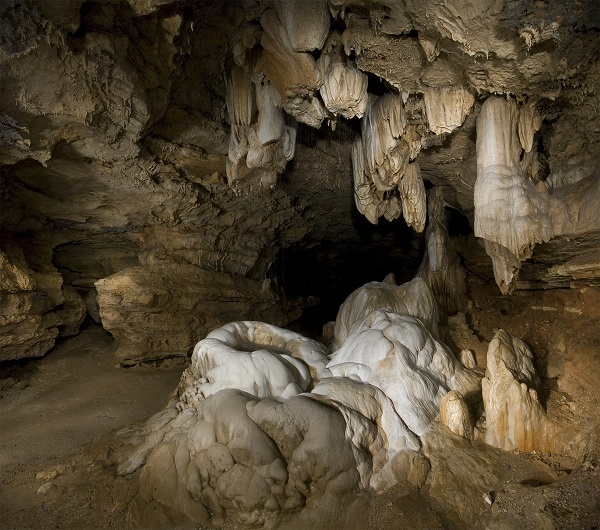at Lake of the Ozarks State Park
 Historically, the native landscape in what is now Lake of the Ozarks State Park was much different from what can be found here today. Fire-maintained woodlands once covered this area, creating an open mosaic of wildflowers, grasses and trees teeming with a variety of wildlife. Clear streams, many of which were fed by underground aquifers and alive with pristine aquatic life, dissected these areas, creating unique environments. Caves and underground water-filled passageways provided cool, clear, unpolluted water for the rest of the ecosystem. These passageways also provided a distinctive habitat for a variety of wildlife and created unique deposits that cannot be replicated on the surface.
Historically, the native landscape in what is now Lake of the Ozarks State Park was much different from what can be found here today. Fire-maintained woodlands once covered this area, creating an open mosaic of wildflowers, grasses and trees teeming with a variety of wildlife. Clear streams, many of which were fed by underground aquifers and alive with pristine aquatic life, dissected these areas, creating unique environments. Caves and underground water-filled passageways provided cool, clear, unpolluted water for the rest of the ecosystem. These passageways also provided a distinctive habitat for a variety of wildlife and created unique deposits that cannot be replicated on the surface.
The park actively manages thousands of acres in the park, restoring those conditions that existed historically. Because the areas have been managed, plants and animals such as Riddell’s goldenrod, Cerulean warblers, spotted salamanders and gray bats can now thrive. These restored natural communities can be experienced by park visitors for generations to come.
Patterson Hollow Wild Area
The 1,275-acre area possesses nice stands of native chert woodlands. During the springtime, the dogwood display is particularly impressive, as is the display of early woodland wildflowers. Drainage from the Patterson Hollow stream bisects the area, but flows only after heavy rains. Small springs and seeps along its course form clear perennial pools in the streambed that are great for wading on a hot summer day. As the summer gives way to fall, the trees will display their red and yellow leaves before the quiet serenity of winter. This quiet wild area can provide a wonderful experience for those interested in observing nature or seeking the peacefulness of a few hours of solitude.
Coakley Hollow Fen Natural Area
This 1,776-acre natural area features a swampy, spring-fed meadow, seeps and a spring branch along Coakley Hollow. Called a fen, this natural area has a constant supply of cool, mineralized water seeping to the surface. Because of the seepage, plants and animals living here must be adapted to saturated soils. The fen community is made up of shrubs and herbaceous plants, many of which are normally found growing several hundred miles north. A self-guiding trail and boardwalk provide access to the fen.
Ozark Caverns
 A walk through Ozark Caverns is a journey into an environment where geologic processes can proceed unhindered by the erratic, erosive forces that shaped the surface landscape. In this protected cave environment, dripping and seeping water can redeposit carbonate materials in the form of soda straws, helictites, stalagmites and a host of other geologic wonders.
A walk through Ozark Caverns is a journey into an environment where geologic processes can proceed unhindered by the erratic, erosive forces that shaped the surface landscape. In this protected cave environment, dripping and seeping water can redeposit carbonate materials in the form of soda straws, helictites, stalagmites and a host of other geologic wonders.
Angel Showers, an unusual cave phenomenon, is a never-ending shower of water that seems to come out of the solid ceiling of rock.
Four species of salamanders, five species of bats and 16 species of invertebrates live in Ozark Caverns. Four of the invertebrate species live exclusively in caves, never venturing out of the protected environment. Ozark Caverns is home to many small, secretive cave animals, such as the blind grotto salamander, which sometimes can be seen on cave tours.






